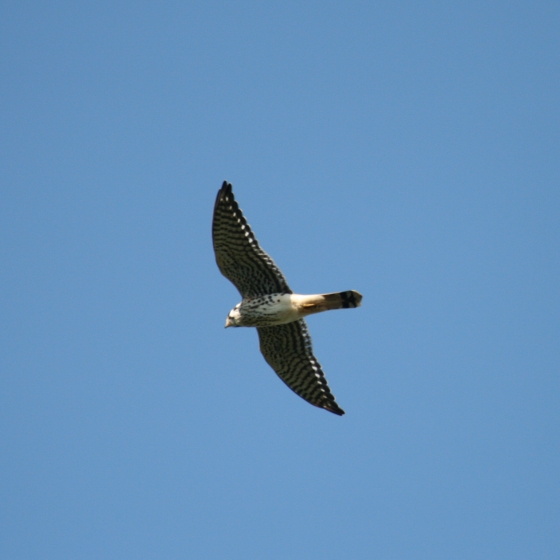American Kestrel

Introduction
Smaller than our Kestrel, males and females normally winter in different habitats in South America (wooded and open, respectively), but occasional individuals have turned up in Britain & Ireland.
This first British record came in late May 1976 (a male on Fair Isle) and was closely followed by an adult female that was discovered 17 days and 900 miles further south on Bodmin Moor in Cornwall.

Key Stats
Status and Trends
Conservation Status
Population Size
Population Change
Population trends of this scarce species are not routinely monitored.
Distribution
This species is a rare vagrant and was recorded during Bird Atlas 2007–11 as shown on the map.
Occupied 10-km squares in UK
or view it on Bird Atlas Mapstore.
Distribution Change
This vagrant is too rarely reported to map distribution change.
Seasonality
This species has been too rarely reported to BirdTrack during 2011–22 to properly assess seasonality.
Movement
Britain & Ireland movement
Biology
Survival and Longevity
Survival is shown as the proportion of birds surviving from one year to the next and is derived from bird ringing data. It can also be used to estimate how long birds typically live.
Classification, names and codes
Classification and Codes
- Order: Falconiformes
- Family: Falconidae
- Scientific name: Falco sparverius
- Authority: Linnaeus, 1758
- BTO 5-letter code: AMEKE
- Euring code number: 3050
Alternate species names
- Catalan: xoriguer americà
- Czech: poštolka pestrá
- Danish: Amerikansk Tårnfalk
- Dutch: Amerikaanse Torenvalk
- Estonian: ameerika tuuletallaja
- Finnish: amerikantuulihaukka
- French: Crécerelle d’Amérique
- German: Buntfalke
- Hungarian: tarka vércse
- Icelandic: Skrúðfálki
- Italian: Gheppio americano
- Latvian: raibais piekuns
- Lithuanian: amerikinis pelesakalis
- Norwegian: Spurvefalk
- Polish: pustulka amerykanska
- Portuguese: quiriquiri / peneireiro-americano
- Slovak: sokol pestrý
- Slovenian: ameriška postovka
- Spanish: Cernícalo americano
- Swedish: sparvfalk

